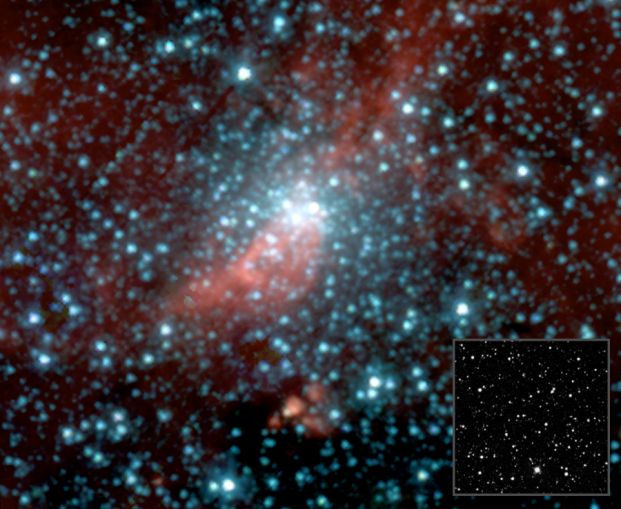
|
Credit & Copyright: H. Kobulnicky
(Univ. of Wyoming)
et al.,
JPL,
Caltech,
NASA
(Visible Light Inset: DSS)
Explanation:
Not a glimpse of
this cluster of stars
can be seen
in the inset visible light image (lower right).
Still,
the infrared view
from the Spitzer
Space Telescope reveals
a massive globular star cluster of about 300,000 suns in
an apparently empty region of sky in the constellation Aquila.
When astronomers used Spitzer's
infrared cameras to peer
through obscuring dust in the plane of our
Milky Way galaxy,
they were rewarded with the surprise discovery of the
star cluster, likely one of the last such
star clusters
to be found.
Globular star clusters normally
roam
the halo of the Milky Way,
ancient relics
of our galaxy's formative years.
Yet the Spitzer image shows this otherwise hidden cluster
crossing through
the middle of the galactic plane some 10,000 light-years away.
At that distance, the picture spans only about 20 light-years.
In the false color infrared image, the red streak is a dust cloud
which seems to lie behind the cluster core.
(Visible Light Inset: DSS)
|
January February March April May June July August September October November December |
| ||||||||||||||||||||||||||||||||||||||||||||||||
NASA Web Site Statements, Warnings, and Disclaimers
NASA Official: Jay Norris. Specific rights apply.
A service of: LHEA at NASA / GSFC
& Michigan Tech. U.
Based on Astronomy Picture
Of the Day
Publications with keywords: infrared - Spitzer space telescope - globular cluster
Publications with words: infrared - Spitzer space telescope - globular cluster
See also:
